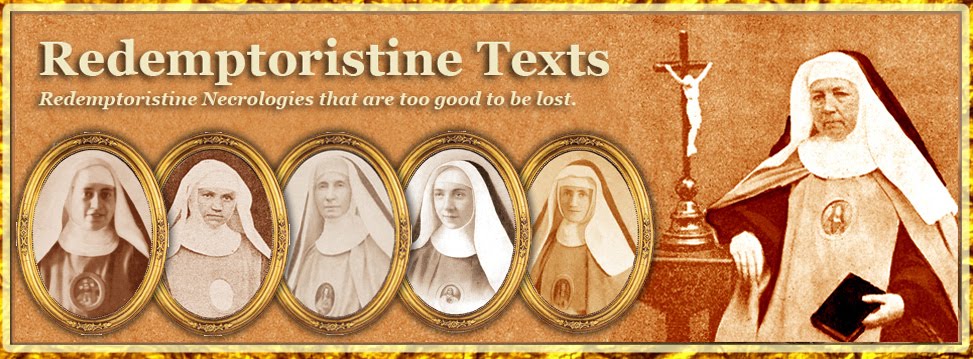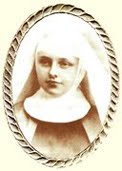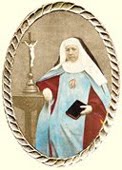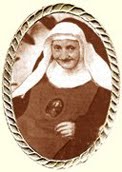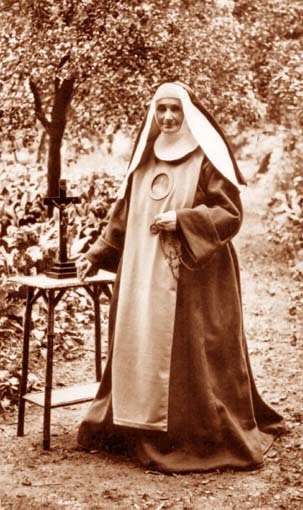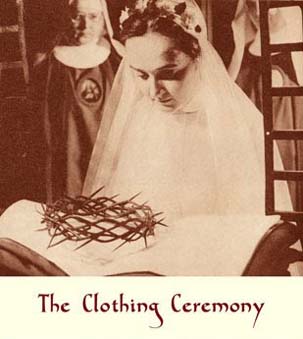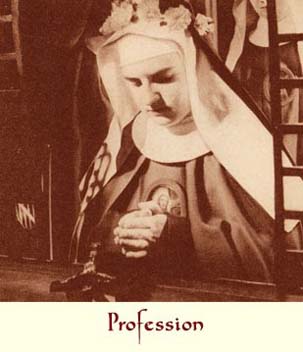Chapter III.
The Monastery of Bruges. - Father Passerat and his Conferences (1846-1850).
The Monastery of Bruges. - Father Passerat and his Conferences (1846-1850).
Let us now get to know a little bit about this Monastery of Bruges (Brugge) where the life of Mother Mary-Aloyse was spent. There are many things about it which will attract our interest.
The foundress was Mother Mary-Alphonsus of the Will of God, who came from Austria with her devoted friend, Sister Mary-Gabrielle of the Most Holy Trinity. When she arrived at Bruges, six choir Postulants and three converse entered. On 23rd March 1843, seven choir sisters made their profession before Monsignor Boussen, the Bishop of Brussels. Trials were not lacking. The house was only provisional, but everyone’s courage was marvellously sustained. Encouraged by frequent letters from the Venerable Father Passerat, Mother Mary-Alphonsus marched bravely at the head of all her sisters, and gave an example of the finest virtues in every respect. Her holy director gives us testimony of it: “Bruges,” he wrote, “will be the flower of the Order, above all in virtues, as I am learning from different sources.” He was invited to come to Bruges. He replied: “Have no doubt that I will do everything that depends on me to come and see you; but, my God, I am certainly not the Messiah, either for you or for your dear educands.” And besides, if the good Father’s words were not kind enough, his lessons were no less worthy of study, as we find witnessed in this letter dated from the end of January 1844, and which our Sister Mary-Aloyse was doubtless familiar with:
“Since you are such good soil, which knows how to make each crop bear fruit, may I be permitted to teach you how to lead the life of Methuselah, even here below.
“How is this to be done? - Be most observant of your holy Rules and Constitutions, and suffer the martyrdom of community life with courage and in a spirit of love; through this you will preserve your Order in its proper fervour until the end of the world.”
Father Passerat was then most concerned to recommend them to flee every deliberate venial sin like death, and concluded with these words. “And so, dear Sisters, fear your little aversions and affections, your slowness to rise in the morning from your beds and be ready for community tasks at the first sound of the bell. Fear this excessive care for your health, your little impatiences, your faults against exterior silence, and especially interior silence, your judgements, no matter how evident may seem the faults that you see; fear all those holy nuances which we know how to give the evil that our hearts desire. Fear, fear... fear as a mortal sin every deliberate venial sin. No deliberate faults at all... none at all, not one. I urgently demand this grace from Jesus Christ through the most holy Heart of Mary for you and for me.” [8]
A year later and Father Passerat came to Bruges in person. The new Redemptoristine convent was finished, and only the chapel remained to be completed. Nonetheless they wished to transfer the community to it new abode. It was on 23rd June 1845, on the stroke of four o’clock in the morning and to the chant of the Benedictus, that the Sisters took possession of their Monastery. The Redemptoristines still remember that admirable scene. The Most Reverend Father Passerat carried the Blessed Sacrament, Mother Mary-Alphonsus and the nuns accompanied her bearing lighted candles. The procession made its way through the cloisters, and finally the holy sacrifice was offered for the first time in the little sanctuary. “The feast lasted three days,” said the Annalist. On 25th June, Mons. Corselis, the Vicar-General, came to bless the Monastery. The following day, His Grace, Mons. Boussen, our Bishop, established the enclosure with great solemnity. The construction of the church was only completed in 1847. On that occasion, the bells were blessed by His Lordship, who himself deigned to open our little church for public worship.”
However, the Revolution of 1848 burst upon them at this time. The Redemptorists fled Vienna and took refuge in America, but four Redemptoristine Sisters came to ask for refuge with their Sisters of Bruges. [9] As for the Most Reverend Father Passerat, he established himself in this town near the Monastery of the nuns. For two years (from 13th September 1848 to 3rd September 1850) he dispensed to them the treasures of his wisdom and his direction.
The advice which he gave Sister Mary-Aloyse is a good indication of the kind of spiritual life inculcated by this Servant of God. It is edifying to see the care with which he attributes everything to Jesus Christ.
“Love Jesus Christ with all your heart,” he tells her, “and retain your affection for His Passion, base all your meditations on it, and aspire to the first place in heaven through your love for Jesus Christ.
“When you suffer and you are prevented from every mortification, remember that in suffering you are praying, you are fasting, and you are fulfilling your whole Rule. This is indeed your mortification. Do not listen to your own nature, which always tells you to descend from the cross. It is a false traitor, and you must not listen to it. Think often of Jesus Christ as you think in the world of a person you love, but think even more of Him who merits it more than any person in the world.
“In your life, unite everything to Jesus Christ. If you suffer, think first of all of Him, and then take the consolation that He gives you. Begin everything in Jesus Christ, and finish everything in Jesus Christ.
“What you must ask of God first of all is courage.
“What is the interior life? It is the life of faith, hope and charity.
“In your meditations, do not think too much; this is how you will obtain the most grace for yourself and others. Love, and do acts of love and gratitude. Do not go so much by the letter of what you read, but let yourself be moved by your affections.
“Be always happy and content. Never reason with the devil, and quickly chase away every sad and troublesome thought. Do not afflict yourself in your temptations.
“Desire to suffer for Jesus Christ. When you suffer interiorly or exteriorly, offer yourself to Jesus Christ to suffer so even until the Day of Judgement if this is His holy will. Unite everything to Jesus Christ: your thoughts, your words, your work, your prayers, your sufferings, and everything.”
This wise and firm direction bore its fruits. Mother Mary-Aloyse was always distinguished by her close union with Jesus and Mary, by the great care which she showed in her actions, by her attention to sanctifying her least sufferings. This fervent professed thus drew great profit from the lessons of her Noviciate. In her conduct towards her neighbour she was always seen to be full of candour and frankness in regard to her Superiors, and most circumspect in regard to her Sisters, and charitable towards them by never judging them, nor criticising them, nor inquiring into their conduct.
Is it not due to this that that we may now apply the promises that she made later to one of her novices:
“In following these counsels, you will be truly happy, as you will enjoy the peace and joy of a good conscience; and when you see the day when you will have to render your account to Our Lord, you will see it arrive without fear and even with joy, as you will be able to say, “Lord Jesus, it is for You that I have lived, have struggled, and have triumphed over myself. It is for You that I wish to die, so as to reunite myself with You forever.” Then you will not regret having reined in your tongue, tamed your character, put a brake on your spirit, and contradicted your heart, because you understand that anything which is not God is nothing.
“May Jesus be all for you. Tell all your troubles to this good and adorable Saviour, and to Mary, his good Mother and your own. They have such compassionate hearts. They will understand you, encourage you, help you and strengthen you.
“Go on ahead before God, remembering that after your death, your good or your bad examples will alone survive you, and do not worry about the conduct of others. For in examining and judging other, you will forget your own shortcomings and fall into pride.”
The foundress was Mother Mary-Alphonsus of the Will of God, who came from Austria with her devoted friend, Sister Mary-Gabrielle of the Most Holy Trinity. When she arrived at Bruges, six choir Postulants and three converse entered. On 23rd March 1843, seven choir sisters made their profession before Monsignor Boussen, the Bishop of Brussels. Trials were not lacking. The house was only provisional, but everyone’s courage was marvellously sustained. Encouraged by frequent letters from the Venerable Father Passerat, Mother Mary-Alphonsus marched bravely at the head of all her sisters, and gave an example of the finest virtues in every respect. Her holy director gives us testimony of it: “Bruges,” he wrote, “will be the flower of the Order, above all in virtues, as I am learning from different sources.” He was invited to come to Bruges. He replied: “Have no doubt that I will do everything that depends on me to come and see you; but, my God, I am certainly not the Messiah, either for you or for your dear educands.” And besides, if the good Father’s words were not kind enough, his lessons were no less worthy of study, as we find witnessed in this letter dated from the end of January 1844, and which our Sister Mary-Aloyse was doubtless familiar with:
“Since you are such good soil, which knows how to make each crop bear fruit, may I be permitted to teach you how to lead the life of Methuselah, even here below.
“How is this to be done? - Be most observant of your holy Rules and Constitutions, and suffer the martyrdom of community life with courage and in a spirit of love; through this you will preserve your Order in its proper fervour until the end of the world.”
Father Passerat was then most concerned to recommend them to flee every deliberate venial sin like death, and concluded with these words. “And so, dear Sisters, fear your little aversions and affections, your slowness to rise in the morning from your beds and be ready for community tasks at the first sound of the bell. Fear this excessive care for your health, your little impatiences, your faults against exterior silence, and especially interior silence, your judgements, no matter how evident may seem the faults that you see; fear all those holy nuances which we know how to give the evil that our hearts desire. Fear, fear... fear as a mortal sin every deliberate venial sin. No deliberate faults at all... none at all, not one. I urgently demand this grace from Jesus Christ through the most holy Heart of Mary for you and for me.” [8]
A year later and Father Passerat came to Bruges in person. The new Redemptoristine convent was finished, and only the chapel remained to be completed. Nonetheless they wished to transfer the community to it new abode. It was on 23rd June 1845, on the stroke of four o’clock in the morning and to the chant of the Benedictus, that the Sisters took possession of their Monastery. The Redemptoristines still remember that admirable scene. The Most Reverend Father Passerat carried the Blessed Sacrament, Mother Mary-Alphonsus and the nuns accompanied her bearing lighted candles. The procession made its way through the cloisters, and finally the holy sacrifice was offered for the first time in the little sanctuary. “The feast lasted three days,” said the Annalist. On 25th June, Mons. Corselis, the Vicar-General, came to bless the Monastery. The following day, His Grace, Mons. Boussen, our Bishop, established the enclosure with great solemnity. The construction of the church was only completed in 1847. On that occasion, the bells were blessed by His Lordship, who himself deigned to open our little church for public worship.”
However, the Revolution of 1848 burst upon them at this time. The Redemptorists fled Vienna and took refuge in America, but four Redemptoristine Sisters came to ask for refuge with their Sisters of Bruges. [9] As for the Most Reverend Father Passerat, he established himself in this town near the Monastery of the nuns. For two years (from 13th September 1848 to 3rd September 1850) he dispensed to them the treasures of his wisdom and his direction.
The advice which he gave Sister Mary-Aloyse is a good indication of the kind of spiritual life inculcated by this Servant of God. It is edifying to see the care with which he attributes everything to Jesus Christ.
“Love Jesus Christ with all your heart,” he tells her, “and retain your affection for His Passion, base all your meditations on it, and aspire to the first place in heaven through your love for Jesus Christ.
“When you suffer and you are prevented from every mortification, remember that in suffering you are praying, you are fasting, and you are fulfilling your whole Rule. This is indeed your mortification. Do not listen to your own nature, which always tells you to descend from the cross. It is a false traitor, and you must not listen to it. Think often of Jesus Christ as you think in the world of a person you love, but think even more of Him who merits it more than any person in the world.
“In your life, unite everything to Jesus Christ. If you suffer, think first of all of Him, and then take the consolation that He gives you. Begin everything in Jesus Christ, and finish everything in Jesus Christ.
“What you must ask of God first of all is courage.
“What is the interior life? It is the life of faith, hope and charity.
“In your meditations, do not think too much; this is how you will obtain the most grace for yourself and others. Love, and do acts of love and gratitude. Do not go so much by the letter of what you read, but let yourself be moved by your affections.
“Be always happy and content. Never reason with the devil, and quickly chase away every sad and troublesome thought. Do not afflict yourself in your temptations.
“Desire to suffer for Jesus Christ. When you suffer interiorly or exteriorly, offer yourself to Jesus Christ to suffer so even until the Day of Judgement if this is His holy will. Unite everything to Jesus Christ: your thoughts, your words, your work, your prayers, your sufferings, and everything.”
This wise and firm direction bore its fruits. Mother Mary-Aloyse was always distinguished by her close union with Jesus and Mary, by the great care which she showed in her actions, by her attention to sanctifying her least sufferings. This fervent professed thus drew great profit from the lessons of her Noviciate. In her conduct towards her neighbour she was always seen to be full of candour and frankness in regard to her Superiors, and most circumspect in regard to her Sisters, and charitable towards them by never judging them, nor criticising them, nor inquiring into their conduct.
Is it not due to this that that we may now apply the promises that she made later to one of her novices:
“In following these counsels, you will be truly happy, as you will enjoy the peace and joy of a good conscience; and when you see the day when you will have to render your account to Our Lord, you will see it arrive without fear and even with joy, as you will be able to say, “Lord Jesus, it is for You that I have lived, have struggled, and have triumphed over myself. It is for You that I wish to die, so as to reunite myself with You forever.” Then you will not regret having reined in your tongue, tamed your character, put a brake on your spirit, and contradicted your heart, because you understand that anything which is not God is nothing.
“May Jesus be all for you. Tell all your troubles to this good and adorable Saviour, and to Mary, his good Mother and your own. They have such compassionate hearts. They will understand you, encourage you, help you and strengthen you.
“Go on ahead before God, remembering that after your death, your good or your bad examples will alone survive you, and do not worry about the conduct of others. For in examining and judging other, you will forget your own shortcomings and fall into pride.”
Footnotes
[8] Souvenirs (Memorials), published by Father Nimal, Redemptorist, 1 vol., p. 128, Liège, Dessain - Paris, Magnin.
[9] These were: in 1848, Sister M. Cherubim who became the Superior at Velp in 1858; - in 1849, Sister Mary-Baptist. She died eight months later, attended by Father Passerat; - in 1850, Sister Mary Fidelis, the granddaughter of Countess Welsersheimb. She left Bruges in 1852 to go to the foundation of Ried. - A converse sister, Sister Alphonsa, had accompanied Sister M. Fidelis to Bruges. Several months later, on 17th January 1851, she went to Galoppe where several Redemptoristines had gathered, waiting for the convent at Marienthal to be finished.
[9] These were: in 1848, Sister M. Cherubim who became the Superior at Velp in 1858; - in 1849, Sister Mary-Baptist. She died eight months later, attended by Father Passerat; - in 1850, Sister Mary Fidelis, the granddaughter of Countess Welsersheimb. She left Bruges in 1852 to go to the foundation of Ried. - A converse sister, Sister Alphonsa, had accompanied Sister M. Fidelis to Bruges. Several months later, on 17th January 1851, she went to Galoppe where several Redemptoristines had gathered, waiting for the convent at Marienthal to be finished.
This necrology is translated from Fleurs de l'Institut des Rédemptoristines by Mr John R. Bradbury. The copyright of this translation is the property of the Redemptoristine Nuns of Maitland, Australia. The integral version of the translated book will be posted here as the necrologies appear.
